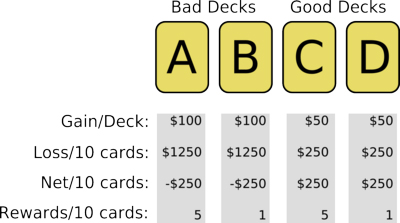Iowa gambling task
From Psy3242
Purpose
The Iowa Gambling Task was created by A. Bechara, H. Damasio, D. Tranel, and A. R. Damasio (1997) of the University of Iowa. It was designed to examine emotion and cognition interaction in decision making. The area of the brain required to perform the Iowa Gambling Task accurately is the dorsolateral and lateral orbital prefrontal cortex. This area of the brain is involved in making right and wrong decisions, predicting future events, and mediating conflict, which are requirements to complete the IGT correctly.
Instructions
The Iowa Gambling Task requires the participant to choose cards from four different decks. Each card has a different amount of money on it and can either result in a gain of profit or a loss. Two of the decks, the green and red, have low monetary rewards but lower losses. These are called the advantageous decks. The other two decks, yellow and blue, have high rewards but even higher losses. The IGT is fixed so that if a person picks cards from the advantageous decks, profit will be made, and if the person picks from the disadvantageous decks, the results are monetary deficits. Most participants begin the task by picking cards from the disadvantageous deck, with the high rewards and even higher losses. After a few trials, the participant should see the pattern of loss and begin choosing from the green and read advantageous decks.
Studies Involving the IGT
Studies done on the Iowa Gambling Task show different areas of the brain at work for age and sex. A study done by Wood, Busemeyer, Coling, Cox, and Davis (2005) indicated that both older and younger adults perform well on the IGT, but have different means of doing so. Older adults (65-88 yrs.) depend on accurate representations of wins and losses depicted through the IGT. Young adults (18-34 yrs.) rely on the learning from the task and memory.
Another study based on sex was performed by Overman, Graham, Redmond, Eubank, Boettcher, Samplawski, and Walsh (2006). The data indicated that women need a personal moral dilemma presented during the Iowa Gambling Task to achieve results close to those of the men. Men's better performance is not because men are mathematically more gifted; instead, women need the personal moral dilemma to activate the dorsolateral prefrontal cortex and lateral orbital prefrontal cortex already activated in men during the IGT.


